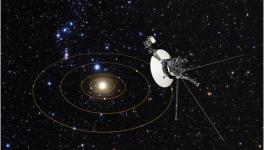Voyager 2 Enters Interstellar Space 40 Years After Launch

Image Courtesy: NASA website.
Voyager 2, after its launch more than 40 years ago, has now entered into the interstellar space, NASA has confirmed. This means that the spacecraft has gone beyond the solar system. This longest running space mission has sent a faint signal from the other side of the solar system that scientists now have decoded.
Voyager 2 is the second NASA craft that has ever been able to travel beyond the solar system. Earlier, Voyager 1 was reported to have crossed this threshold some six years ago. Both Voyager 1 and Voyager 2 were launched in the same year 1977. In fact, Voyager 2 was launched a month prior to Voyager 1, which took the scenic route across the solar system and provided the only close up images of Uranus and Neptune.
Now, Voyager 2 has sent some of the most detailed pictures of the border of our solar system. The NASA scientists were apprehensive at the outset of the journey whether it would survive to see this landmark of crossing the border of the solar system.
“We didn’t know how large the bubble was and we certainly didn’t know that the spacecraft could live long enough to reach the edge of the bubble and enter interstellar space,” said Prof Ed Stone, of the California Institute of Technology, who has been working on the mission since before its launch in 1977.
Both the craft travelled beyond the heliosphere, a large bubble consisting of supersonic charged particles streaming outward from the sun. The heliosphere is very unique in nature and its unique character was first revealed by Voyager 1. It is the region where the charged particles rushing out from the sun at supersonic speed meet a cooler interstellar wind, blowing in from supernovae that exploded millions of years ago. It was once thought that the solar wind faded away gradually with distance, which was nullified by the data provided by Voyager 1. This data confirmed that there is a boundary defined by a sudden drop in temperature combined with an increase in the density of charged particles known as plasma.
Voyager 2 has provided new insights into the nature of the heliosphere’s limits. Five papers published in Nature Astronomy revealed that the heliosphere boundary encountered by Voyager 2 was much sharper and thinner than what Voyager 1 had crossed. The shape of the heliosphere can also be traced to having a leading edge like that of a blunt bullet from the second dataset.
“It implies that the heliosphere is symmetric, at least at the two points where the Voyager spacecraft crossed. That says that these two points on the surface are almost at the same distance,” said Bill Kurth, a University of Iowa research scientist and a co-author of one of the studies.
The Voyager 2 is still beaming back signals from beyond the heliosphere, which are taking more than 16 hours to reach Earth.
Both the Voyagers are powered by steadily decaying plutonium and are projected to drop below critical energy levels by mid 2020s. Even after that they will continue on their trajectories long after they fall silent.
Get the latest reports & analysis with people's perspective on Protests, movements & deep analytical videos, discussions of the current affairs in your Telegram app. Subscribe to NewsClick's Telegram channel & get Real-Time updates on stories, as they get published on our website.
















